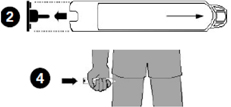
Key Recommendations
1. Epinephrine is the first line medication that should be used for the emergency management of a person having a potentially life-threatening allergic reaction.It is recommended that epinephrine be given at the start of a known or suspected anaphylactic reaction. Epinephrine should be injected into the muscle of the mid-outer thigh.
2. Antihistamines and asthma medications should not be used instead of epinephrine for treating anaphylaxis.3. All individuals receiving epinephrine must be transported to hospital immediately (ideally by ambulance) for evaluation and observation.It is optimal to have individuals transported to hospital by paramedics or local emergency medical services. While epinephrine is usually effective after one injection, the symptoms may recur and further injections may be required to control the reaction. Repeat attacks have occurred hours later without additional exposure to the offending allergen. Therefore, it is recommended that a person suffering from an anaphylactic reaction be observed in an emergency facility for an appropriate period because of the possibility of either a “biphasic” reaction (a second reaction) or a prolonged reaction.
For most individuals, a reasonable length of observation time is four to six hours. This time may vary depending on the judgment of the attending physician who will take into consideration factors such as the severity of the reaction, the person’s response to treatment, previous episodes, and distance from the hospital to the person’s home. More caution should be used in people with asthma because most fatalities associated with anaphylaxis occur in these individuals.
Upon discharge from hospital, an epinephrine auto-injector prescription should be obtained and immediately filled, if not already available.
4. Additional epinephrine should be available during transport to hospital. A second dose of epinephrine may be given as early as five minutes after the first dose if there is no improvement in symptoms.The second dose of epinephrine should only be given in situations in which the allergic reaction is worsening or not improving.
5. Individuals with anaphylaxis who are feeling faint or dizzy because of impending shock should lie down unless they are vomiting or experiencing severe respiratory distress.To improve blood circulation, caregivers should assist in lifting the person’s legs and keeping the legs raised by putting something (e.g. a pillow) underneath. The person should continue to lie down until emergency responders arrive or until they have fully recovered. If the person feels nauseated or is vomiting, lay the person on his or her side to keep the airway clear and prevent choking on vomit. (Note: individuals having difficulty breathing should be kept sitting up).
Do not make the person sit or stand immediately following a reaction (even if treated) as this could result in another drop in blood pressure.
Individuals at risk should be advised to seek help when experiencing an allergic reaction and not to go off alone (e.g. to the washroom) if they are feeling unwell. If they are alone and lose consciousness, no one will know they need help.
6. No person experiencing anaphylaxis should be expected to be fully responsible for self-administration of an epinephrine auto-injector.Individuals may not physically be able to self-administer epinephrine when they are suffering from a reaction.
They may be anxious about using a needle, may downplay the seriousness of a reaction, or may not want to draw attention to themselves. They may also be confused. Assistance from others, especially in the case of children or teens, is crucial in these circumstances.
Location of Epinephrine Auto-Injectors (“auto-injectors”)
Auto-injectors must be kept in locations which are easily accessible (for example not in locked cupboards or drawers) but out of reach of young children. They should not be exposed to extreme cold (fridge/freezer) or heat (glove box in a vehicle).
The locations should be known to all staff members and caregivers. Individuals at risk of anaphylaxis are advised to carry an auto-injector at all times and tell others where the device is kept, in case of an emergency.
Auto-injector expiry dates must be checked regularly to ensure that devices have not expired.
Children who have demonstrated maturity (usually by the age of six or seven) should carry their own epinephrine. Many children learn to carry their auto-injector in a waist-pack by the time they are in grade one or two.
This will vary depending on the child’s development and skill level, level of support provided and education of peers and caregivers. In the case of younger children, staff may have to carry the auto-injector or have it available in the classroom.
Classmates and friends should be taught not to play with an auto-injector.
